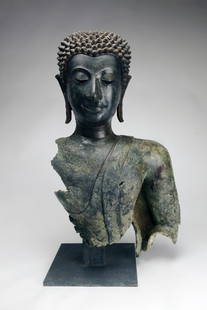
Rare 17th Century French Style Life Size Complete Suit
Similar Sale History
Recommended Items










Item Details
Description
Rare 17th Century French Style Museum Quality Suit of Armor | An Authentic Life Size Italian Etch Full Suit of Plate Armor is decorated with embossed symbols including the French Fleur-de-lis | Likely made in the 18th Century | The armor is attached to a black base | The Suit of Armor includes an authentic period long sword typical of the European High Middle Ages (sometimes called knightly sword or arming sword) | The sword is a straight, double-edged weapon with a single-handed cruciform hilt measuring 47 inches | Dimensions: 70_ H (Tall) without base; 77_ H (Tall) with base x 19_ W at shoulders x 12 Ó D at the feet | This suit of armor is complete with the following: a helmet Ð to protect the head a gorget (or bevor) Ð steel collar designed to protect the throat pauldrons Ð armor designed to protect the shoulder areas besagews Ð armor that protects the armpits (in this case a winged pauldron version) couters Ð plate armor designed to protect the elbow areas (in this case an articulated joint couter) vambraces Ð armor designed tot protect the forearms gauntlets Ð armor to protect the hands (in this case fully articulated plate armor with extended cuff covering part of the forearm) cuirass Ð back and breastplate with a fauld Ð pieces of plate armor worn below a breastplate to protect the waist and hips tassets Ð piece of plate armor designed to protect the upper thighs cuisses Ð form of medieval armor worn to protect the length of the thigh poleyns Ð armor that protected the knees greaves Ð armor that protects the shins, and sabatons Ð armor that covers the feet Sword Condition: This suit of armor is in very good museum quality condition considering its age and use. Some light inactive surface rust. Leather straps attaching the above pieces of armor are intact. Plate armor is a historical type of personal body armor made from iron or steel plates, culminating in the iconic suit of armor entirely encasing the wearer. While there are early predecessors such as the Roman-era lorica segmentata, full plate armor developed in Europe during the Late Middle Ages, especially in the context of the Hundred YearsÕ War, from the coat of plates worn over mail suits during the 13th century. In Europe, plate armor reached its peak in the late 15th and early 16th centuries. The full suit of armor is thus a feature of the very end of the Middle Ages and of the Renaissance period. Its popular association with the Òmedieval knightÓ is due to the specialized jousting armor which developed in the 16th century. Full suits of Gothic plate armor were worn on the battlefields of the Burgundian and Italian Wars. The most heavily armored troops of the period were heavy cavalry such as the gendarmes and early cuirassiers, but the infantry troops of the Swiss mercenaries and the landsknechts also took to wearing lighter suits of Òthree quartersÓ munition armor, leaving the lower legs unprotected. The use of plate armor declined in the 17th century, but it remained common both among the nobility and for the cuirassiers throughout the European wars of religion. After 1650, plate armor was mostly reduced to the simple breastplate (cuirass) worn by cuirassiers. This was due to the development of the flintlock musket, which could penetrate armor at a considerable distance. For infantry, the breastplate gained renewed importance with the development of shrapnel in the late Napoleonic wars. By about 1420, complete suits of plate armor had been developed. A full suit of plate armor would have consisted of a helmet, a gorget (or bevor), pauldrons, besagews, rondels, couters, vambraces, gauntlets, a cuirass (back and breastplate) with a fauld, tassets and a culet, a mail skirt, cuisses, poleyns, greaves, and sabatons. The very fullest sets, known as garnitures, more often made for jousting than war, included pieces of exchange, alternate pieces suiting different purposes, so that the suit could be configured for a range of different uses, for example fighting on foot or on horse. A complete suit of plate armor made from well-tempered steel would weigh around 15Ð25 kg (33-55 pounds). The wearer remained highly agile and could jump, run and otherwise move freely as the weight of the armor was spread evenly throughout the body. The armor was articulated and covered a manÕs entire body completely from neck to toe. In the 15th and 16th centuries, large bodies of men-at-arms numbering thousands or even more than ten thousand men (as many as 60% of an army) were fighting on foot wearing full plate next to archers and crossbowmen. This was commonly seen in the Western European armies especially of France and England during the Hundred Years War, the Wars of the Roses or the Italian Wars. European leaders in armoring techniques were northern Italians, especially from Milan, and southern Germans, who had somewhat different styles. But styles were diffused around Europe, often by the movement of armourers; the Renaissance Greenwich armor was made by a royal workshop near London that had imported Italian, Flemish and (mostly) German craftsmen, though it soon developed its own unique style. Ottoman Turkey also made wide use of plate armor but incorporated large amounts of mail into their armor, which was widely used by shock troops such as the Janissary Corps. The fleur-de-lis (plural: fleurs-de-lis)[pron 1] or flower-de-luce is a stylized lily (in French, fleur means ÒflowerÓ, and lis means ÒlilyÓ) that is used as a decorative design or symbol. Many of the saints are often depicted with a lily, most prominently St. Joseph. Since France is a historically Catholic nation, the Fleur de lis became commonly used Òat one and the same time, religious, political, dynastic, artistic, emblematic, and symbolicÓ, especially in French heraldry.
Dimensions
77 x 20 x 12 in
Buyer's Premium
- 20%
Rare 17th Century French Style Life Size Complete Suit
Estimate $10,000 - $15,000
11 bidders are watching this item.
Shipping & Pickup Options
Item located in Gallatin, Tennessee, usSee Policy for Shipping
Payment

TOP





















































